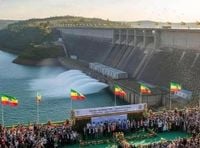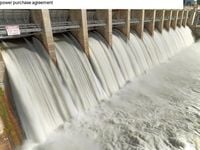On September 9, 2025, Ethiopia officially inaugurated the Grand Ethiopian Renaissance Dam (GERD), marking a historic moment for both the country and the African continent. Towering above the Blue Nile near the Sudanese border, the $5 billion hydroelectric project is now Africa’s largest dam, with the capacity to generate up to 6.45 gigawatts (GW) of clean energy—enough to more than double Ethiopia’s current electricity production and potentially light up millions of homes and industries across East Africa.
But as Ethiopia celebrated what Prime Minister Abiy Ahmed called “a symbol of African progress,” the mood downstream was anything but jubilant. Egypt, which depends on the Nile for 97% of its water, quickly renewed warnings that the dam threatens its very survival. The stakes, as officials in Cairo put it, are nothing less than existential: more than 100 million Egyptians rely on the Nile for drinking water, farming, and industry, and nearly 95% of the country’s population lives along its banks. Any disruption to the river’s flow could spell disaster for food supplies and daily life.
“A major drop in supply threatens Egypt’s internal security. The stakes are economic, political, and deeply social,” Mohamed Mohey el-Deen, a former member of Egypt’s assessment team for the GERD, told reporters. President Abdel Fattah al-Sisi has repeatedly declared that Egypt will defend its rights to the Nile, describing the GERD as an “existential threat.” According to Egypt’s Ministry of Foreign Affairs, Ethiopia pressed ahead with filling the dam’s massive reservoir—capable of holding nearly 74 billion cubic meters of water—without proper consultation or a legally binding agreement, violating international law and long-standing treaties such as the 1929 Anglo-Egyptian Treaty and the 1959 Nile Waters Agreement.
Sudan, too, has voiced reservations, warning that Ethiopia’s actions could alter the basin’s delicate hydraulic regime. Both Egypt and Sudan have insisted on clear mechanisms for managing water during droughts, but negotiations since 2015 have failed to yield a binding agreement. Mediation efforts by the United States, Russia, the United Arab Emirates, and the African Union have all stalled, leaving the dispute at a diplomatic impasse.
Despite the diplomatic standoff, Ethiopia has remained resolute, emphasizing its sovereign right to use its own resources for economic growth and poverty alleviation. Prime Minister Abiy Ahmed addressed the controversy directly at the dam’s inauguration, stating, “Ethiopia has no intention of harming anyone and wants the dam to be seen as a regional asset rather than a regional threat.” He added, “Ethiopia will never take away your rightful share. The hunger of our brothers in Egypt and Sudan is also our hunger. We must share and grow together.”
The GERD has become a powerful symbol of national pride and self-reliance for Ethiopians. More than 90% of the project’s funding came from Ethiopian sources—state contributions, diaspora donations, and bond sales—making it a rare example of a megaproject built without heavy reliance on foreign donors or lenders. Ethiopian President Taye Atsike Selassie called the dam’s launch “a reward for Ethiopians’ persistence.”
The engineering feat is nothing short of remarkable. The project consists of four cascading dams, with the main structure rising 170 meters high and stretching 1,800 meters long. On December 28, 2014, the GERD set a world record by placing 23,000 cubic meters of roller-compacted concrete in just 24 hours. The dam’s reservoir, stretching 172 kilometers, is one of the largest in the world, and its capacity to hold 74 billion cubic meters of water has been a major sticking point for Egypt and Sudan, who fear the impact on their own water supplies.
Yet for Ethiopia, the GERD is about more than energy. Nearly half the country’s population lacks access to electricity, and the dam is seen as the linchpin of a strategy to electrify the nation, boost industries, and become a regional exporter of power. Projected revenues from energy exports could reach $1 billion annually, potentially shifting the economic balance in East Africa. Neighboring countries have taken notice: Kenya’s President William Ruto, who attended the inauguration, hailed the Ethiopia-Kenya power interconnector as delivering “clean, affordable electricity that strengthens energy security, stabilizes supply during droughts, and supports industrial growth.” South Sudan’s President Salva Kiir Mayardit announced plans to procure power from the GERD, saying, “We believe that the progress of one nation is the progress of all; together we can turn our challenges into opportunities, peace, stability and growth.”
The dam’s completion also positions Ethiopia as a key player in Africa’s transition to renewable energy. Designed and built by Webuild, GERD is not only the continent’s largest hydropower project but also a milestone in regional power integration. The chairman of the African Union Commission, Mohammed Ali Yusuf, remarked that the dam “has provided evidence that Africa can build.”
Still, the controversy over the GERD highlights the complex web of interests and anxieties surrounding the Nile, which supports more than 250 million people across 11 countries. The Blue Nile alone contributes about 85% of the water that flows into the greater Nile River. For Egypt, any reduction in water flow is a red line; for Ethiopia, the dam is a once-in-a-generation chance to transform its economy. The dispute has remained largely diplomatic, but analysts warn that the lack of compromise could deepen mistrust and fuel one of Africa’s most enduring geopolitical flashpoints.
Observers say the core issue is trust. The African Union and other mediators have urged all parties to return to the negotiating table and seek a cooperative path forward. If managed wisely, the GERD could power growth across East Africa, improve resilience against droughts and floods, and set a precedent for shared management of transboundary water resources. But if the deadlock continues, the risk of escalation remains.
The GERD’s story is, at its heart, a tale of ambition, anxiety, and the search for balance in a region where water is both lifeblood and lightning rod. As Ethiopia’s turbines begin to spin, the eyes of Africa—and the world—will be watching to see whether the dam becomes a bridge to prosperity or a flashpoint for conflict.


